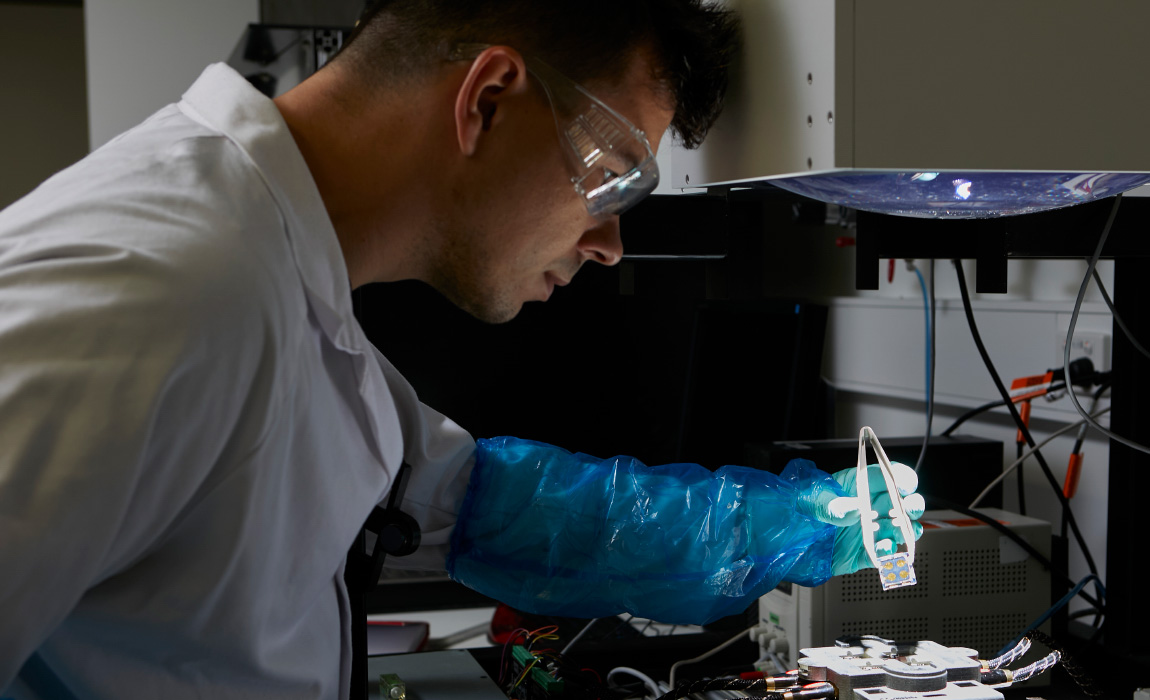From years to weeks: Machine learning & robotics turbo charges solar cell research

Dr Adam Surmiak working on automatic device characterisation at Monash University
And it’s not limited to perovskites. The machine learning model and automated system can also potentially be used to crunch the numbers and run tests on silicon solar cells, metal-organic frameworks and other key areas in the field of materials science.
“We've spent almost AU$5.4 million on a system that can fabricate catalysts, hydrogen-based materials, organic photovoltaics and thin films for perovskites or other materials,” Adam said.
“Whatever materials you're going to put in, the system can fabricate for you in an inert atmosphere.
“The samples get characterised, the data is extracted and it's directly run through machine learning and artificial intelligence algorithms. It’s a feedback system for material recipe improvement aimed at large-scale commercial and industrial production.”
And using data generated by the system, Dr Nastaran Meftahi and Professor Salvy Russo developed a new type of machine learning model capable of predicting huge volumes of promising chemical recipes for new perovskite solar cells using only the recipes themselves, with no other information needed.
Crucially, the facility operates without the need for spin coating, which requires user expertise and is difficult to automate.
The device saves researchers countless hours and eliminates the defects and reproducibility problems caused when prototype cells are made by hand.
Significantly, Adam has now created a range of novel, reproducible perovskite solar cells solely from the recipes developed through a combination of machine learning and the high-throughput fabrication system.
The team’s combined work, published in the journal Advanced Energy Materials, has resulted in reproducible perovskite solar cells with power-conversion efficiencies of 16.9%, manufactured without human intervention.
As more data becomes available through further automated testing, the model’s capacity will increase from thousands to predict potentially millions of useful recipes accurately and effectively.
“First Adam developed 16 novel devices never seen before using his novel setup, and I used that to predict the properties of 256,” Nastaran said.
“Then Adam and his group developed 100 new devices and that let me predict the properties of 16,000!
“At Monash they'll soon be able to make 2,000 unique devices per day. So, we're quickly getting into predicting the properties of millions of different devices.
“And you can't do that with anybody else's machine learning model, because you'd need additional information before you've made the device.”
Unlike conventional machine learning models, Nastaran’s approach does not require other information about the material to produce a specific outcome. The device recipe itself is all that’s needed to generate highly valuable outputs.
“It’s a bit like aerospace engineering,” Nastaran said.
“Normally, you need to manufacture and stress test all the components like wings, nose and tail first. By the time you’re done, you may as well have built and flown the entire plane.
“With my model, the schematics alone will tell you with certainty if it will fly or not.”
Research groups and materials manufacturers around the world are now set to benefit from the new infrastructure’s speed and accuracy.
“Instead of hiring someone for two or three years to perform these studies, they can achieve that in two or three weeks,” Adam said.
In addition to Monash University’s Dr Sebastian Fürer and Dr David McMeekin (now at the University of Oxford) and Dr Hao Deng, the CSIRO team of Dr Doojin Vak and Dr Anthony Chesman and Caria Evans at the University of Georgia also made a vital contribution, while Exciton Science Associate Investigator Dr Andrew Christofferson and Professor Dave Winkler of La Trobe University assisted the modelling.
“Without us all doing overtime and weekend work, not even a single cell would have been made,” Adam said.
“I’m so grateful for the efforts of all my colleagues who stuck at it. It’s truly unique and an astonishing achievement.”
The project was funded by grants from the Australian Renewable Energy Agency (ARENA)and the Australian Centre for Advanced Photovoltaics (ACAP), as well as the Australian Research Council. The fabrication works were performed at Melbourne Centre for Nanofabrication, Monash X-Ray Platform and Monash Centre for Electron Microscopy.
Houston, we have a solution
Step change in upconversion the key to clean water, green energy & futuristic medicine